Shamanic Vestments
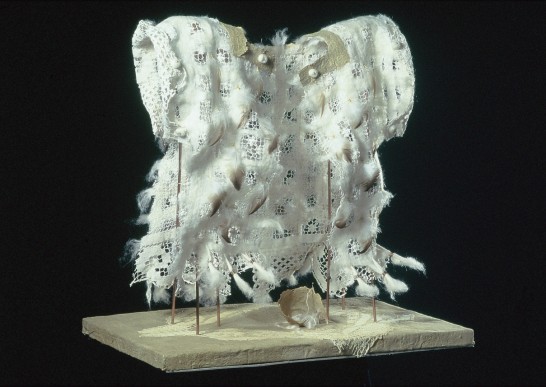
The series of works entitled ‘Shamanic Vestments’ was inspired by a dream. The titles of works were taken from legends of Inuit Shamans. Shamans are found in hunting and gathering cultures with no social organization. The word ‘Shaman’ means ‘one who is excited or raised’. The Inuit people endured extremely harsh environmental conditions, so a Shaman was essential to survival because he/she could communicate with, and even influence the forces that controlled mens’ lives. Feather garments were associated with a Shaman’s transformation and his relationship with helping spirits. The titles relate to particular shamans, all of whom have the most marvelous stories.
Image 1: AGGIARTOQ’S VESTMENT (felt, paper (New Zealand flax, red hot poker, sweet corn, cumbungi), gold thread, brass beads, eagle feathers, bamboo).
450 x 320 x 500 mm.
Aggiartoq, a novice shaman, was tied to a long tent pole and pushed through a hole in the ice so that he stood on the bottom of a lake. He was left there for five days, and when he was brought up again he was completely dry, proving his Shamanic status.
Image 2: KINALIK’S VESTMENT (antique lace, felt, god thread, copper wire, brass beads, paper (iris), eagle feathers, copper pipe). 420 x 380 x 450 mm.
Another young Shaman, Kinalik, was suspended from tent poles for five days, exposed to cold and snow, and was then shot with a small s tone. She lay dead for a whole night. The next morning, her instructor was to call her to life again, but she awoke of her own accord.
Image 3: UVAVNUK’S VESTMENT (felt (sheep’s hair), alpaca, paper (New Zealand flax), gold thread, gold beads, eagle feathers, copper pipe).
420 x 380 x 450 mm
Uvavnuk underwent a spectacular assault from her helping spirit – a ball of fire. Whilst outside one evening, she saw a glowing ball of fire rushing toward her. Before she could flee, the fireball struck her and entered her body. At the same moment she knew that all within her grew light, and, from that moment she became a great shaman.
Image 4: NIVIATSIAN’S VESTMENT (felt, gold thread, brass beads, paper (coastal sword sedge, cumbungi), eagle feathers.
Niviatsian was attacked by a walrus, when out hunting. He had many wounds, including a pierced lung. He was placed in a small snow hut of his own. It was believed that if he had gone to an unclean dwelling, he would have died. Alone in his igloo, Niviatsian completely recovered in 3 days, and thus became a great Shaman. The walrus became his helping spirit.
Image 5: TUNGRALIK’S VESTMENT (felt, handspun silk, gold thread, brass beads, eagle feathers, paper (iris), steel rod). 420 x 380 x 450 mm.
The Shaman, unlike his fellow Inuit, was capable of dealing with all sorts of spirits, but he had to have the support of helping spirits. Because life in Alaska was more precarious than other areas, a Shaman, usually called ‘angaqok became called ‘tungralik’, meaning ‘the one who has spirits’, which thus enabled him to deal with the tortuous nature of life as an Inuit.
Image 6: ANGAKOQ’S VESTMENT (felt, paper – mask and base – cumbungi, gold thread). 420 x 380 x 450 mm.
Angakoq is the name given to an Inuit who receives a spirit prior to becoming a ‘tungralik’.
Image 7: AMAJORUK’S VESTMENT (felt, paper (red hot poker), gold thread, brass beads, eagle feathers). 420 x 380 x 450 mm.
Niviatsian was also attacked by his two other helping spirits; whilst out hunting, a wolverine wrestled with him for a full day. His third spirit, the ogress Amajoruk, attacked and put him in her bag before he knew what was happening. After he managed to cut his way out of her ‘amaut’, she became his helping spirit as well.
Image 8: AUA’S VESTMENT (felt (alpaca), handspun silk, gold thread, brass beads, copper pipe, paper (New Zealand flax, red hot poker), feathers).
200 x 200 x 220 mm
Aua’s helping spirit was her namesake. ‘When it came to me it was as if the passage and roof of the house were lifted up, and I felt such a power of vision, that I could see right through the house, in through the earth and up into the sky; it was the little Aua that brought me all this inward light, hovering over me as long as I was singing’.
Image 9: IGJAJARJUK’S VESTMENT (felt, paper (red hot poker, cumbungi), handspun silk, gold thread, brass beads, feathers, copper pipe).
200 x 200 x 220 mm.
Igjagarjuk was the instructor of both Kinalik and Aggiartoq. He had become a Shaman by undergoing a lengthy exposure to hunger and cold. He fasted intermittently for six months, after which he was taken to a tiny igloo where he stayed for thirty days with nothing but tepid water to drink.

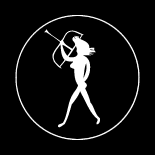
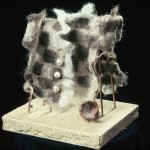
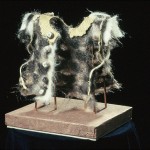
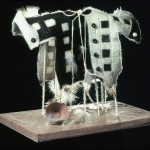
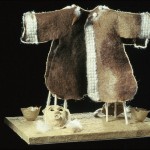
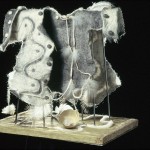
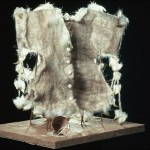
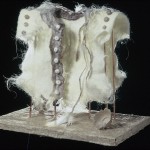
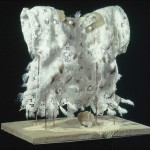
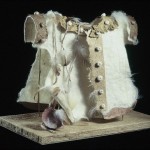
MEG ~ Your Art is Gentle & Exquisite ~ so detailed & professional